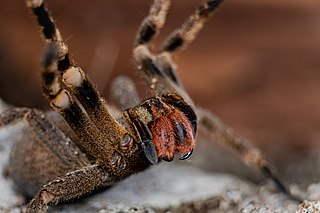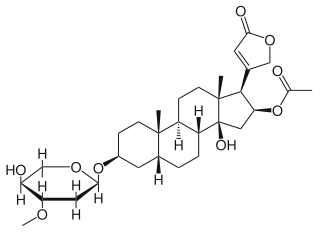Related Research Articles

In vitro studies are performed with microorganisms, cells, or biological molecules outside their normal biological context. Colloquially called "test-tube experiments", these studies in biology and its subdisciplines are traditionally done in labware such as test tubes, flasks, Petri dishes, and microtiter plates. Studies conducted using components of an organism that have been isolated from their usual biological surroundings permit a more detailed or more convenient analysis than can be done with whole organisms; however, results obtained from in vitro experiments may not fully or accurately predict the effects on a whole organism. In contrast to in vitro experiments, in vivo studies are those conducted in living organisms, including humans, known as clinical trials, and whole plants.

Toxicology is a scientific discipline, overlapping with biology, chemistry, pharmacology, and medicine, that involves the study of the adverse effects of chemical substances on living organisms and the practice of diagnosing and treating exposures to toxins and toxicants. The relationship between dose and its effects on the exposed organism is of high significance in toxicology. Factors that influence chemical toxicity include the dosage, duration of exposure, route of exposure, species, age, sex, and environment. Toxicologists are experts on poisons and poisoning. There is a movement for evidence-based toxicology as part of the larger movement towards evidence-based practices. Toxicology is currently contributing to the field of cancer research, since some toxins can be used as drugs for killing tumor cells. One prime example of this is ribosome-inactivating proteins, tested in the treatment of leukemia.

Francesco Redi was an Italian physician, naturalist, biologist, and poet. He is referred to as the "founder of experimental biology", and as the "father of modern parasitology". He was the first person to challenge the theory of spontaneous generation by demonstrating that maggots come from eggs of flies.

Chelation therapy is a medical procedure that involves the administration of chelating agents to remove heavy metals from the body. Chelation therapy has a long history of use in clinical toxicology and remains in use for some very specific medical treatments, although it is administered under very careful medical supervision due to various inherent risks, including the mobilization of mercury and other metals through the brain and other parts of the body by the use of weak chelating agents that unbind with metals before elimination, exacerbating existing damage. To avoid mobilization, some practitioners of chelation use strong chelators, such as selenium, taken at low doses over a long period of time.

Mitragyna speciosa is a tropical evergreen tree in the coffee family native to Southeast Asia. It is indigenous to Thailand, Indonesia, Malaysia, Myanmar, and Papua New Guinea, where it has been used in herbal medicine since at least the 19th century. It has also historically been used for chewing, smoking, and tea. Kratom has opioid properties and some stimulant-like effects.

Envenomation is the process by which venom is injected by the bite or sting of a venomous animal.

Naja is a genus of venomous elapid snakes commonly known as cobras. Members of the genus Naja are the most widespread and the most widely recognized as "true" cobras. Various species occur in regions throughout Africa, Southwest Asia, South Asia, and Southeast Asia. Several other elapid species are also called "cobras", such as the king cobra and the rinkhals, but neither is a true cobra, in that they do not belong to the genus Naja, but instead each belong to monotypic genera Hemachatus and Ophiophagus.

Phoneutria nigriventer is a species of medically significant spider in the family Ctenidae, found in the Southern Cone of South America. Along with other members of the genus, they are often referred to as Brazilian wandering spiders.

Veratrum album, the false helleborine, white hellebore, European white hellebore, or white veratrum is a poisonous plant in the family Melanthiaceae. It is native to Europe and parts of western Asia.

Diphenylprolinol (D2PM), or (R/S)-(±)-diphenyl-2-pyrrolidinyl-methanol, is a norepinephrine-dopamine reuptake inhibitor which is used as a designer drug.
Ethylene glycol poisoning is poisoning caused by drinking ethylene glycol. Early symptoms include intoxication, vomiting and abdominal pain. Later symptoms may include a decreased level of consciousness, headache, and seizures. Long term outcomes may include kidney failure and brain damage. Toxicity and death may occur after drinking even in a small amount as ethylene glycol is more toxic than other diols.

Oleandrin is a cardiac glycoside found in the poisonous plant oleander. As a main phytochemical of oleander, oleandrin is associated with the toxicity of oleander sap, and has similar properties to digoxin.

Eugeroics, also known as wakefulness-promoting agents and wakefulness-promoting drugs, are a class of drugs that promote wakefulness and alertness. They are medically indicated for the treatment of certain sleep disorders including excessive daytime sleepiness (EDS) in narcolepsy or obstructive sleep apnea (OSA). Eugeroics are also often prescribed off-label for the treatment of EDS in idiopathic hypersomnia. In contrast to classical psychostimulants, such as methylphenidate and amphetamine, which are also used in the treatment of these disorders, eugeroics typically do not produce marked euphoria, and, consequently, have a lower addictive potential.
International Society on Toxinology (IST) is a global society of scientists and clinicians working for the advancement of venoms, poisons and toxins. It was founded in 1962 with an aim to advance knowledge on venoms, poisons and toxins of animal, plant and microbial origin.

Furanylfentanyl (Fu-F) is an opioid analgesic that is an analog of fentanyl and has been sold as a designer drug. It has an ED50 value of 0.02 mg/kg in mice. This makes it approximately one fifth as potent as fentanyl.

MDMB-CHMICA is an indole-based synthetic cannabinoid that is a potent agonist of the CB1 receptor and has been sold online as a designer drug. While MDMB-CHMICA was initially sold under the name "MMB-CHMINACA", the compound corresponding to this code name (i.e. the isopropyl instead of t-butyl analogue of MDMB-CHMINACA) has been identified on the designer drug market in 2015 as AMB-CHMINACA.

Steven A. Seifert (1950–2022) was an American medical toxicologist. He was a professor of emergency medicine at the University of New Mexico, as well as the medical director of the New Mexico Poison and Drug Information Center. Since 2017, he was the editor-in-chief of Clinical Toxicology. He was also a jazz tenor saxophonist.

25G-NBOMe (NBOMe-2C-G) is a derivative of the phenethylamine hallucinogen 2C-G, which acts as a highly potent agonist for the human 5-HT2A receptor.

25iP-NBOMe is a derivative of the phenethylamine hallucinogen 2C-iP, which acts as a highly potent agonist for the human 5-HT2A receptor.
References
- ↑ Kini, R. Manjunatha (June 2020). "Toxinology provides multidirectional and multidimensional opportunities: A personal perspective". Toxicon: X. 6: 100039. doi:10.1016/j.toxcx.2020.100039. ISSN 2590-1710. PMC 7285919 . PMID 32550594.
- ↑ White, Julian; Warrell, David; Eddleston, Michael; Currie, Bart J.; Whyte, Ian M.; Isbister, Geoffrey K. (2003). "Clinical toxinology--where are we now?". Journal of Toxicology. Clinical Toxicology. 41 (3): 263–276. doi:10.1081/clt-120021112. ISSN 0731-3810. PMID 12807310.